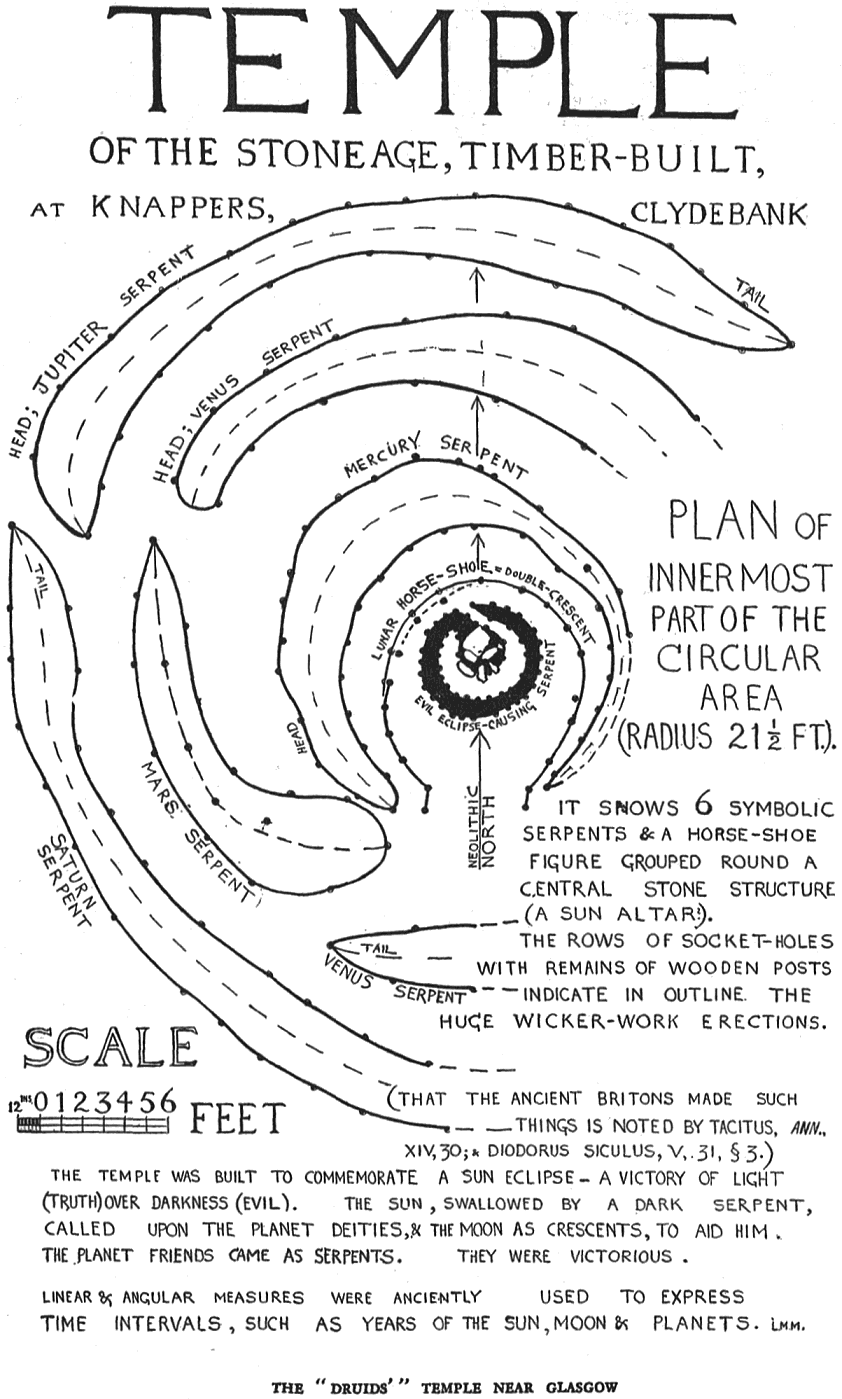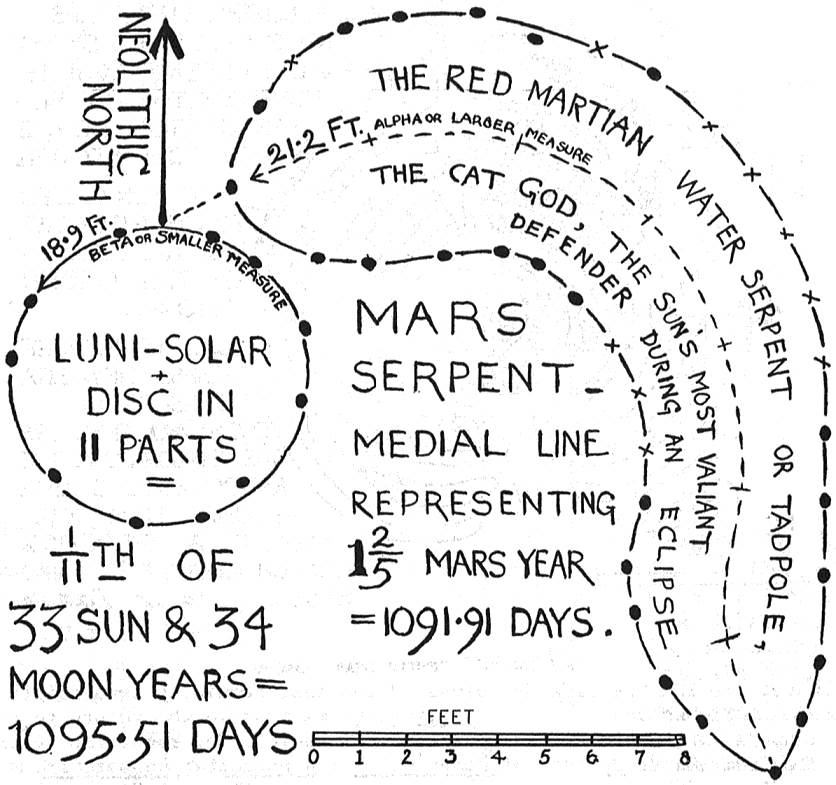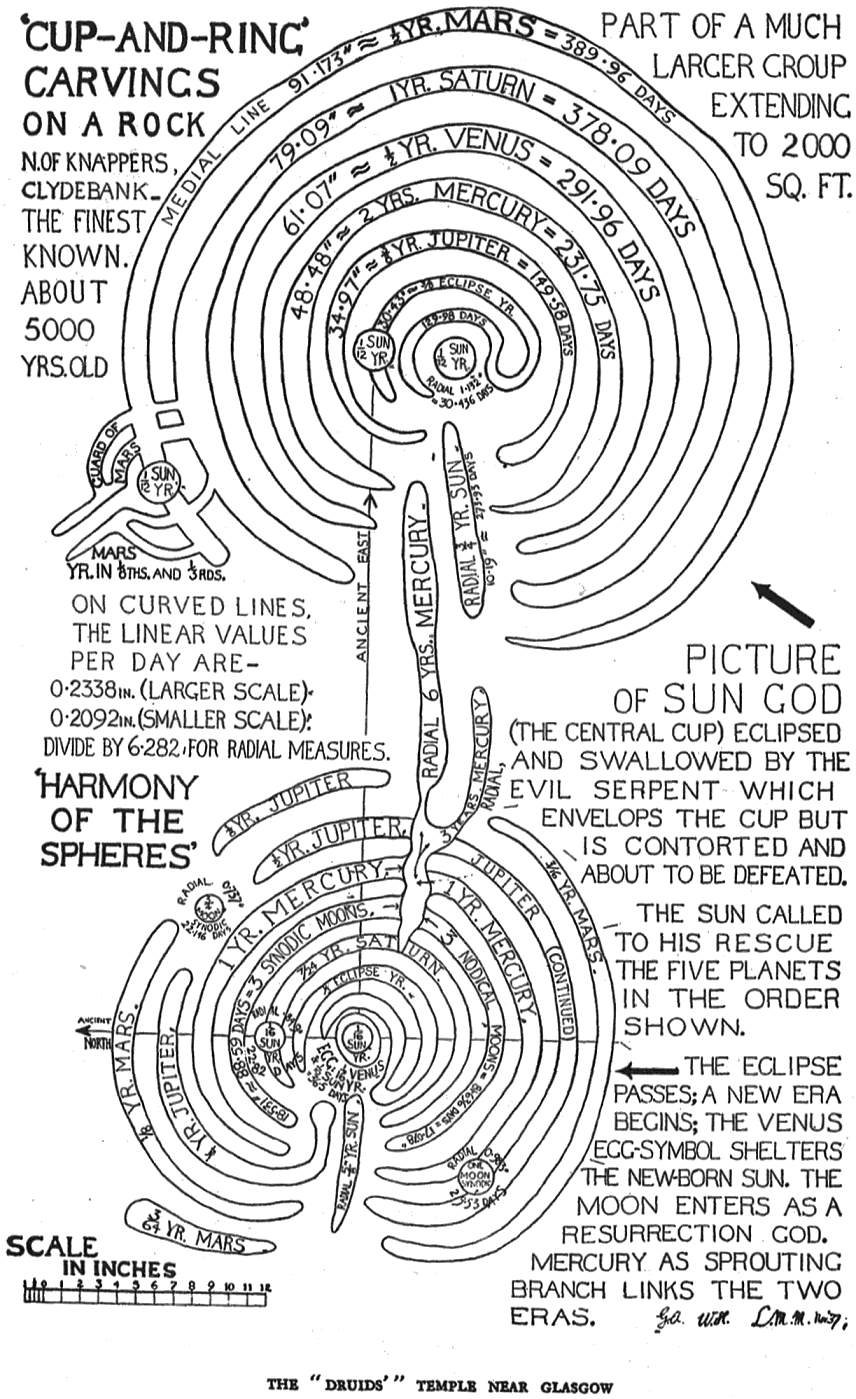
Journal of Geomancy vol. 3 no. 1, October 1978
This article contains most of Ludovic MacLellan Mann’s booklet An Appeal to the Nation: The “Druids’ ” Temple near Glasgow (1937). Mann wrote a second booklet on the subject, The Druid Temple Explained, in 1939. See elsewhere on this website for the complete text of both booklets.
{16}

{17}
SO little is known about science and religion in prehistoric Britain that any scraps of well-authenticated knowledge of pre-Christian philosophy become of priceless value.
By good fortune, in July, 1937, sand-diggers accidentally uncovered some stone-built graves which were soon proved to be in close association with a magnificent, timber-built, sacred edifice of circular form.
The place is situated in Dumbartonshire, at Knappers Farm, exactly seven miles about N.-W. of Glasgow, on the edge of the new arterial roadway which runs from Glasgow to Dumbarton.
For some 5000 years the site has remained intact and undisturbed save for the wasting of the timber superstructure.
The burial-places were found in their original condition with remarkable grave furnishings, many of them unique and new to science.
All that remains of the timber structures are the socket-holes of timber uprights. They are filled with remains of decayed carbonized wood and are often surrounded by a packing of clay and small stones.
The nature of the soil, a fine, stoneless porous sand, has not encouraged the growth of trees, and hence there has been no disruption of the prehistoric surface by roots.
Moles have, however, done some damage to the socket-holes.
As the sand-digging threatened to carry away a large section of the structures the edge of the pit for some 70 yards had without delay to be shored up. This was done by sanction of the proprietor, Captain Robert Bush Black, of Auchentoshan, and the lessee, Mr. Edward Miller. Some years ago graves were found on the outskirts of the circular arena and were examined by these gentlemen, and by Messrs. J. M. Davidson, Wm. Rogerson and John Gentles, but the writer was unable to attend regularly through illness.
The shoring-up work has been carried on from dawn to dusk by willing workers around the broken segment of the circular arena.
Between the barricade of railway sleepers erected and the crumbling, 15-feet high, sandy precipice the workers packed tons of turf.
Their labours occupied several weeks and when finished secured for the time being the safety of the monument.
Work was then continued without interruption in the baring of the surface down to the prehistoric level.
Hundreds of socket-holes were disclosed, and it is no exaggeration to state that none would have been noticed unless the ancient surface had been cautiously examined by the slow and laborious process of slicing it with a hand-knife in thin horizontal layers.
This examination revealed that the timber uprights were sometimes oval and sometimes circular and it gave their exact dimensions in horizontal cross-section.
During the work hundreds of stone implements, some of flint, but most of them of native rock material, were found embedded in the old surface.
They include nearly every class of Late Stone Age implement. Spokeshaves of stone, probably used by the timber-workers in the shaping of the wooden standards, are very common.
Our architects carefully plotted each post-hole. It was found that the structure was made up of concentric palisadings and that the interspaces contained vestiges of symbolic figures delineated and outlined by a succession of wooden structures in curvilinear disposition.
Most of the structures were in the shape of huge serpents, and evidence was forthcoming that these had been constructed of wicker-work, like gigantic cages or baskets. This recalls the remarks of classical writers as to the use by the Ancient Britons of monster wicker baskets of symbolic form.
In the open spaces between each serpentine construction, and each concentric palisading there were encountered some dozens of graves with both inhumed and cremated remains. These are of various shapes and styles and are covered with settings of stones. Most of them were furnished with an oval or circular basket-like cover. The central stone in the top setting was often found to have near its middle the sculpturing of an egg-shaped cavity, thought to be a symbol of resurrection and new life.
No effort has yet been made fully to uncover the graves as the investigators prefer, first, to complete the ground-plan of the area.
The timber structures are found to extend over an area with a radius of at least 129 feet from the centre, at which has been found a stone structure which conceals a small rectangular chamber.
Though graves closely surround this central point, it seems to have been an altar and not a burial-place.
It is closely encompassed by socket-holes which outline the form of a coiled serpent, the large head of which envelops the supposed altar. Beyond this serpent figure, as brought out by an {18} examination of the post-holes, there is an oval penannular structure similar in aspect to the inner horseshoe at Stonehenge.
At its western side the horseshoe structure has been pressed inwards by storm action, indicating that the upright posts were lintelled. Outside of and encompassing the horseshoe there are five monster serpentine figures, while, still farther out, symmetrically arranged, are several coiled serpents. In concentric zones beyond these are other apparently similar configurations but these have not yet been fully examined. The groups of snake figures which surround the supposed altar recall some cryptic passages in the “Book of Revelation.”
The pottery found in the graves is hand-made, and often beautifully decorated, and ranges from the round-based vessel of the Late Stone Age to vessels characteristic of the various phases of the Bronze Age. This would indicate that the Temple was erected in the Stone Age and continued in use, at least as a burial-ground, for many centuries into the Bronze Age.
All the implements and ornaments which have been found comply in their dimensions with the standard prehistoric linear units. The pottery vessels also agree with the units, as do the more important stones used in the grave structures. The sculptured emblems on some of these stones conform exactly to the ancient measures.
The layout of the whole arena is systematic and precise. By interpreting the linear and angular dimensions into astronomical recurrent periods each serpent figure can be identified from the length of its medial line with one or other of the heavenly bodies—the Sun, the Moon, and the five planets, or with the evil spirit of the Eclipse Year.
The various circular palisadings are found to represent the main astronomical periods such as the luni-solar cycle of 19 years or the Saros cycle of 18 years 10½ days, at the end of which eclipses may recur.
These circles are represented singly, or in multiples up to six, at which distance the radius is 129 feet.
By these means a reconstruction of the prehistoric system of equating time-intervals with linear intervals can be demonstrated.
It can be shown with mathematical precision that at Knappers there was a temple of gigantic proportions erected during the Late Stone Age to commemorate a solar eclipse.
The architect of this great work has left to us a portrayal similar to that described in Egyptian and other ancient writings, which tells of a monster dragon or serpent rising from the dark underworld and swallowing the Sun God.
At this crisis the Sun God called for the help of his colleagues in the celestial pantheon, the Moon Deity and the five planet divinities.
The first came in crescent form, or as two crescents conjoined like a horseshoe, while the other five divinities assumed the guise of serpents.
These allies of the Solar Monarch at last vanquished the black serpent and once more Light and Truth prevailed over Darkness and Evil, and a new astronomical era began.
This episode is also shown in magnificent detail, cut on an adjoining rock-surface—the so-called cup-and-ring marked rock.
The rings are not rings but serpents, some good and some bad.
By the application of the system of ancient measures eclipses can be dated from rock-carvings. These markings, as well as timber structures and stone circles, were laid out on a plan similar to that of a clock-face, or a spider’s web, but rigorously geometrical.
The palisaded circles at Knappers were divided on a nineteenth divisional system, because the luni-solar or Metonic cycle comprised 19 solar years, while the Saros, a cycle of 18 years 10½ days, comprised 59 eclipse years.
The radii dictated the position, and ran through loci of prehistoric importance.
The unique timber-built temple at Knappers, on the Duntochcr Boulevard, Glasgow, has been under examination during the last few weeks by Mr. Ludovic Mann and party and Captain Robert Bush Black, of Auchentoshan, the proprietor. It has now been pronounced to be the finest prehistoric building in wood yet discovered.
The turf has been bared over a wide area, and the temple shows up as a circular structure not less than 86 ft. in radius. The ground-plan, as shown by the socket-holes which originally contained large wooden posts, demonstrates a very precise and symmetrical arrangement, involving circles, ellipses, and a large number of serpentine figures. Adjoining the temple is a cemetery with 53 burials, both cremated and inhumed, with grave furnishings and stone settings, many of them of an unusual nature. The vessels found are in four classes and belong to the Stone Age and the succeeding Bronze Age. This remarkable structure throws a flood of new light on the religion of ancient Britain many centuries before the arrival of the Romans.
{19}
Close to the burial of the Bronze Age discovered last week at Knappers Sand Pit, Kilbowie, another interment of apparently the same period has been exposed by the sand-diggers. It greatly differs in character from that first discovered, and seems to be unique. It was examined yesterday and on Monday by Messrs. Miller, Rogerson, and Ludovic Mann.
About 18 ins. under the turf was found a roughly circular area about 4 ft. in diameter set with 13 easily portable stones. Beneath these was found a vertical cylindrical shaft, 9 ft. deep, dug in the fine white sand. It was 2 to 3 ft. in diameter except where the shaft expanded at the top to 4½ ft.
It was found packed with brown earth and 95 easily handled, mostly rolled, stones. Some of these had sculpturings upon them, and 20 small quartz tools were found in the shaft.
Near the base excavations with a pen-knife revealed the carbonized remains of a large pannier-like basket, 15½ ins. in diameter, apparently of hazel twigs, the mainstays being set about 2 ins. apart.
The basket had a bluntly concave base. In it were found traces, also carbonized, of a wooden dish, nearly 6 1-5 ins. high, with a rim diameter of nearly 9½ ins. The wall at the rim was everted and the base was rounded like the bowls of the late Stone Age. The vessel was set tilted to the north about 22 degrees from the vertical.
The basket with its contained bowl was not placed quite centrally at the base of the shaft but lay about 10 ins. from the middle point towards the north-east.
Examination of the material on the floor of the shaft showed that the pit had been dug some considerable time before the burial was placed in it. Probably the inhumed body was placed in ossuary before the final obsequies.

Typical wicker figures, their sizes expressing harmony between the Sun, Moon, and Mars.
{20}

Editor’s Note: The IGR has already recovered the last remaining typescripts of Mann’s never-published book A Lost Civilization. We hope in the future to reprint other work by Mann, especially his metrological studies. The recovered typescript is available from IGR as Occasional Paper No. 7; A Forgotten Researcher. @ 75p.